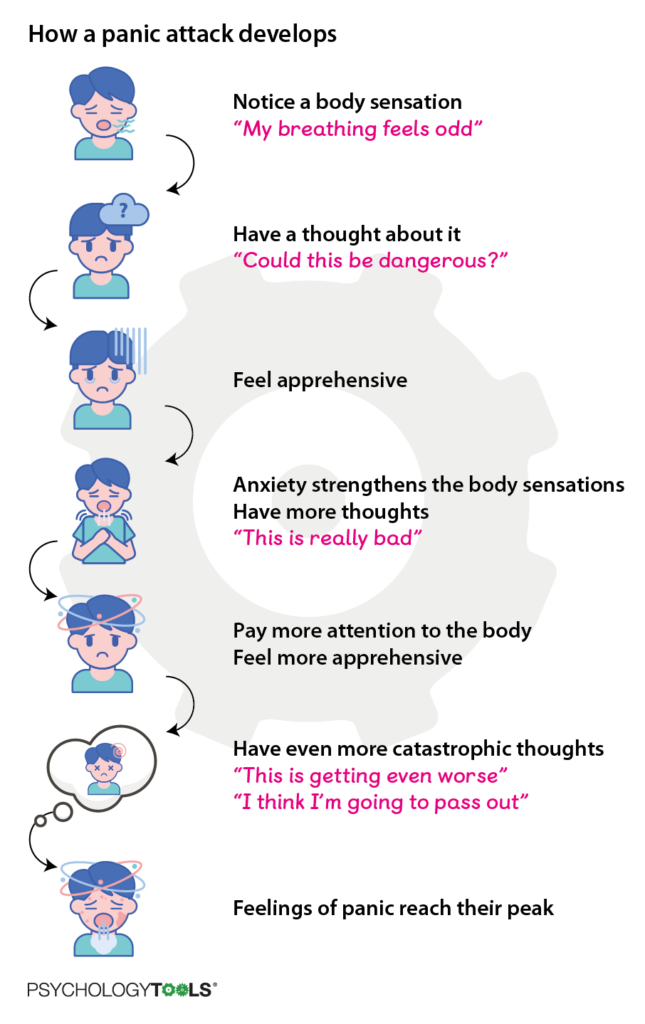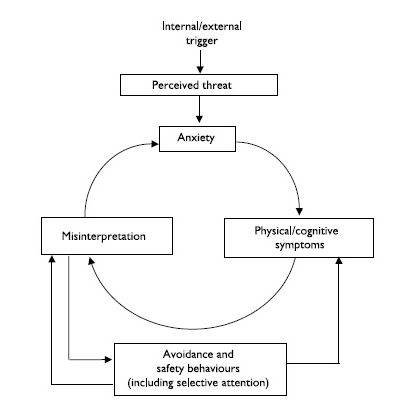- A Quick Guide
- What is a panic attack?
- The Panic attack cycle
- 1. A stressor or biological factor triggers a normal physical or psychological response in a person.
- 2. The person misinterprets the normal mind and body reactions and gives them an incorrect catastrophic explanation.
- 3. He/She believes the incorrect catastrophic explanation.
- 4. Belief in the incorrect catastrophic explanation aggravates the physical and psychological reactions. This increases the intensity of symptoms which further strengthens the belief, and continues the loop.
- 5. Safety and Avoidance strategies are developed to tackle future panic attacks. These strategies trigger even more panic attacks.
- 6. The person believes the ineffective safety and avoidance strategies prevent panic attacks and continues to perform them. This perpetuates panic disorder.
A Quick Guide
Many people suffer from panic disorder or experience panic attacks when faced with overwhelming stressors of life. Yet, surprisingly the majority of them are unaware of what actually goes on to trigger this frightening experience. A person’s not knowing what is happening to them during a panic attack, is even more distressing since it adds to the feeling of helplessness. Thus, to empower them, the present article will discuss what happens when you have a panic attack and elaborate on the panic attack cycle.
But first,
What is a panic attack?
A panic attack refers to a feeling of intense fear that triggers severe physical reactions and catastrophic thoughts about dying, going crazy, losing control, having a heart attack, etc. The symptoms peak within a few minutes and often occur suddenly, in absence of any apparent threat. Recurrent panic attacks may create fear of future attacks. As a result, the person adopts safety behaviors to avoid them. In such cases, a single panic attack gradually transitions into a panic disorder.
Watch: [What is a Panic Attack?]
The Panic attack cycle
To understand what happens when you have a panic attack, we will discuss the explanation given by David M. Clark (1986). According to him, a certain chain of events occurs in a panic attack. When these repeat over time, it leads to the development of a full-blown panic disorder. The panic attack cycle is as follows:


1. A stressor or biological factor triggers a normal physical or psychological response in a person.
An external stressor or an internal thought/image/feeling initiates the onset of changes in the mind and body of a person. For example, Bodily sensations (increased heart rate or headaches, etc due to a slight change in blood pressure, tiredness) and mental experiences (anxiety, excitement, and stress, which often bring physiological changes and racing thoughts).
For example,
Ahmed, a 25-year-old university student, was quite terrified of the contagious nature of the covid-19 virus. He knew the symptoms on his fingertips, followed all the safety precautions, and took special care of his health. One day, a few hours before his final exam (stressor), he noticed an increase in his heart rate. Along with that, his breathing became quicker and more difficult (normal anxiety response with physiological changes).
2. The person misinterprets the normal mind and body reactions and gives them an incorrect catastrophic explanation.
Such normal physiological and psychological reactions are taken as a sign that something horrible is about to happen. In other words, the person predicts an immediate catastrophe. For instance, a slight increase in heart rate may be misinterpreted as a heart attack. The misinterpretation happens only in panic disorder when panic attacks occur repeatedly. Whereas, the first panic attack does not involve this misinterpretation and is simply due to biological or psychological factors.
For example,
Ahmed had a normal anxiety reaction to his exam looming nearer. However, he mistakenly thought the shortness of breath due to his anxiety was because he had caught the covid-19 virus.
3. He/She believes the incorrect catastrophic explanation.
The individual starts to strongly believe the misinterpretations especially while the panic attack is happening. Common thoughts include: ‘I am dying’, ‘ I am going crazy’, ‘I cannot control myself’, ‘I am having a heart attack’, ‘I cannot breathe. It is suffocating’, ‘I am going to choke’, ‘I will faint or I will collapse any second’, ‘’ I am having a seizure’ etc.
For example,
Ahmed started thinking, ‘I have contracted the virus. I cannot breathe. I am going to die’.
4. Belief in the incorrect catastrophic explanation aggravates the physical and psychological reactions. This increases the intensity of symptoms which further strengthens the belief, and continues the loop.
The above-mentioned catastrophic thoughts increase a person’s anxiety and fear. These negative emotions aggravate the pre-existing mild physiological symptoms and make them more severe. Accordingly, the person’s belief in their previous catastrophic explanation grows stronger. This induces more symptoms, and the panic attack cycle continues.
For example,
Thoughts of suffocating and dying due to Covid-19 increased Ahmed’s fear and anxiety response. His breathing became more labored, his heart was pounding like crazy, and he felt sweaty and energy leaving his body. He felt like he would collapse any second. Upon noticing the new symptoms, he thought ‘This proves it. I am going to choke and die’. This thought further increased his fear and the severity of his physical symptoms. All of this happened in a few minutes.
5. Safety and Avoidance strategies are developed to tackle future panic attacks. These strategies trigger even more panic attacks.
Once an episode is over, the person develops coping strategies to prevent future panic attacks. Almost all strategies are unhealthy and ineffective. In fact, they strengthen the person’s false beliefs and set off the panic attack cycle. A few examples of this include:
- To be prepared for a future attack, the person becomes hypervigilant of bodily sensations and mental experiences. This heightened awareness of any slight normal bodily or mental reactions is again misinterpreted which set off the panic attack cycle.
- Some people due to their fear of suffocating may start breathing rapidly. This contributes to hyperventilation and other symptoms. Again, strengthens their belief that they are suffocating.
For example,
The episode lasted for 1 hour which was terrifying. To prevent this from happening again, Ahmed started watching the news and read extensively about the experiences of people with the virus. He also became more vigilant of his body and health. This new increased attention to his bodily changes started setting off frequent panic attacks.
6. The person believes the ineffective safety and avoidance strategies prevent panic attacks and continues to perform them. This perpetuates panic disorder.
Instances, when the panic attack does not occur, are attributed to unhealthy coping strategies/safety behaviors. This continues the cycle of future panic attacks.
For example,
When the panic attack did not occur, Ahmed thought it was because he was over-prepared and ready for it after watching the news, taking extra precautions, and being more aware of his body. Whereas in reality, this was maintaining the panic attack cycle.
The above article discussed the underlying mechanism of a panic attack and a panic disorder. If you found this explanation useful and want to know your unique panic attack cycle to understand your personal experience, check out this article. If you want to know more about panic attacks and how to identify them, read about them on our website.


